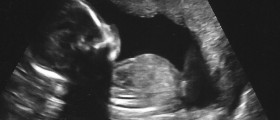
Ultrasound testing is a medical procedure which involves exposing specific parts of a person's body to high-frequency sound waves, which the human ear normally cannot hear. These waves pass through the body and help the computer form images which display the inside of a person's organism.
Among many diagnostic purposes that this device has, it can also be used during pregnancy, helping the doctor obtain images of the fetus by scanning the abdominal area.
Ultrasound in Pregnancy
The purpose of prenatal ultrasound lies mainly in its ability to provide images of the baby, of the amniotic sac and the placenta, as well as the ovaries. Therefore, if some birth complications are present, ultrasound is likely to display them without problems, helping the health experts develop an adequate treatment strategy.
Most of the ultrasound procedures are carried out topically, on the top of the pregnant woman's skin. However, in order for the waves to penetrate the skin more easily, a special type of conductive gel is used, increasing the quality of the received image.
Yet, not all prenatal ultrasound procedures are carried out this way. Sometimes, a transvaginal ultrasound may be necessary, being a procedure which uses a tubular probe placed inside the vaginal canal. Even though this type of scanning produces images of a much higher quality, it is not practiced on a regular basis. Rather, it is solely used if there are some potential complications affecting the uterus or the ovaries, allowing the patient and the health practitioner to rule out or diagnose some health issues timely.
In general, this form of scanning and diagnosis is performed around the 20th week of pregnancy. Then, the doctor confirms that the placenta is normally attached and healthy, seeing that the baby is growing and functioning correctly. The ultrasound provides information about the heartbeats of the baby and the movements of his/her limbs, therefore making it possible for the doctor to observe the progress and notice and potential problems.
Additionally, by the 20th week, the gender of the baby is clearly visible and the ultrasound scanning can determine this feature. Yet, mistakes can be made during this form of assessment and the sex of the baby is commonly misinterpreted.
Some other situations where ultrasound may come in handy is determining whether there is more than a single baby in the uterus, seeing how old the baby actually is, making sure that he/she is healthy and well positioned and assessing his/her expected body weight.
With the age of modern technology, ultrasound imaging has been taken to the next level. Thus, today, we have 3D and even 4D ultrasound scanning devices at our disposal, allowing either still, 3D images or moving, video-like, real-time ultrasound footage. This makes it possible for doctors to get an even better insight into the health of the baby and the mother, noticing any complications on time and reacting immediately if something goes wrong.
Is Ultrasound Safe?
Taking into consideration that this form of imaging does not use the harmful X-ray radiation, but, rather, sound waves which do not damage the tissue in any way, ultrasound is considered to be completely harmless, both for the mother and the fetus, as well as for all other patients who undergo this diagnostic procedure.
Also, ultrasound imaging does not produce any side-effects after the procedure is done. Therefore, it is absolutely safe from this standpoint too.
Yet, the frequency of your exposure to ultrasound scanning may need to be regulated, depending on a group of important factors. Namely, if your pregnancy is considered to be a low-risk one, you will not need more that 3 ultrasound exposures during the whole process.
On the other hand, of you are older than 35 or if you are carrying twins, the number of necessary ultrasound exposures may increase, due to the fact that your pregnancy is labeled as potentially risky. This also applies for pregnant women who suffer from medical conditions such as the presence of tumors, cysts or aging placenta, since all of these situations can lead to potential health problems, affecting both the mother and the child.
All women undergo a dating scan, carried out during the 12th week of their pregnancy. After this scanning procedure, the health expert gives the mother a probable date of labor. Note that, in case that some complications like bleeding are present, the scanning may take place earlier, even during the 6th week.
All in all, ultrasound scanning has been labeled as completely safe for all pregnant women and their babies since it is a procedure which does not involve any harmful or damaging radiation. Nevertheless, not more than 3 scans are performed if the baby and the mother are completely healthy.
Ultrasound scanning is an invaluable tool of prenatal health care and all women are advised to take advantage of this useful and safe imaging device.

















Your thoughts on this
Loading...